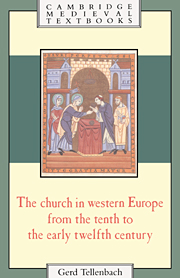Book contents
- Frontmatter
- Contents
- Translator's note
- Author's preface
- List of abbreviations
- 1 Western Christendom and its environment in the tenth and eleventh centuries
- 2 The church and its manifestations on earth
- 3 The material existence of the churches and the clergy
- 4 Religious life and thought
- 5 The beginnings of the revolution in church history
- 6 Gregory VII (1073–1085)
- 7 Continuing conflicts between established principles
- 8 Pope, church, and Christendom
- Epilogue
- Select bibliography
- Index
- Cambridge Medieval Textbooks
5 - The beginnings of the revolution in church history
Published online by Cambridge University Press: 05 June 2012
- Frontmatter
- Contents
- Translator's note
- Author's preface
- List of abbreviations
- 1 Western Christendom and its environment in the tenth and eleventh centuries
- 2 The church and its manifestations on earth
- 3 The material existence of the churches and the clergy
- 4 Religious life and thought
- 5 The beginnings of the revolution in church history
- 6 Gregory VII (1073–1085)
- 7 Continuing conflicts between established principles
- 8 Pope, church, and Christendom
- Epilogue
- Select bibliography
- Index
- Cambridge Medieval Textbooks
Summary
THE PREHISTORY
The question whether the ground was prepared in the first half of the eleventh century for the changes which took place within the church and Christianity in the second half can be answered only cautiously and incompletely. The changes took place at different times in the lands and regions of western Europe with differing preconditions. What we can know is dependent on highly incomplete and not always reliable information. In consequence we are often faced with casual observations and can thus offer no more than suppositions.
If the authors of the late tenth or early eleventh centuries mentioned an increase in church-building this can be interpreted simply as an expression of increases or shifts in population, which are known from other sources. The imaginative Rodulfus Glaber reported enthusiastically that after the millennium the world clothed itself in a white robe of churches. We can observe that an internal colonisation accompanied population increase in a number of western countries from the middle of the tenth century onwards: this meant clearing woods, marshes, and river beds for agriculture. Many new settlements and estates arose, and fortifications were built. The initiative for these new settlements generally came from ecclesiastical and secular landlords. The consequence was that people were no longer prepared to put up with distant parish churches and sought a chapel or church of their own. It may be that the thought of economic gain played a part, but so did religious wishes, as is suggested by contemporary interest in the acquisition of relics and in the veneration of saints.
- Type
- Chapter
- Information
- Publisher: Cambridge University PressPrint publication year: 1993



